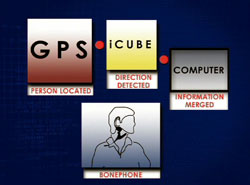BACKGROUND:
Georgia Tech researchers in Atlanta are developing a wearable computing system called the System for Wearable Audio Navigation (SWAN) to help the blind, firefighters, soldiers, and others who must navigate in unknown territory, particularly when vision is obstructed or impaired.
The system provides auditory cues to guide the user from place to place. The researchers are now adapting the system for indoor use, and for use on PDAs and cell phones.
HOW IT WORKS:
The SWAN system combines research developments in
artificial intelligence,
robot tracking and audio interfaces.
It consists of a small laptop worn in a backpack, a proprietary tracking chip, Global Positioning System (GPS) sensors, a digital compass, a head tracker, four cameras, a light sensor.
There is also special headphones that send auditory signals via
vibrations through the skull without plugging the user's ear. (The blind in particular rely heavily on their hearing.)
The sensors and tracking chip send data to the SWAN applications on the laptop, which computes the user's location and in what direction he is looking.
It then maps the travel route and
sends 3-D audio cues to the bone phones to guide the traveler along a path to the destination.
ABOUT 3-D AUDIO:
The 3-D audio for navigation is unique to SWAN; other navigation systems use speech cues.
3-D cues sound like they are coming from 1 meter away from the user's body, in whichever direction he needs to travel.
This is a common sound effect, created by taking advantage of humans' natural ability to detect inter-aural time differences. The 3-D sound application schedules sounds to reach one ear slightly faster than the other, and the human brain uses the timing difference to figure out where the sound originated.

HEAR, HEAR:
Our ears detect sound as vibrations in the air.
Those sound waves cause the eardrum to vibrate, sending waves through a fluid inside the cochlea.
This, in turn, causes tiny hairs -- each tuned to the different pitches of the sound -- to vibrate as well, stimulating nerves which send electrical signals to the rain for processing.
Having two ears makes it possible to determine from where a sound is coming. Time lag and differences in volume provide useful clues.
For instance, sound coming from one direction will reach the ear furthest away about 1/500 second later than the closer ear, and the brain can detect this time lag.
A difference in volume between the two ears depends on the frequency of the sounds.
It is easier for us to tell the direction of high frequency sounds better than low frequency sounds, because the higher frequencies are more easily blocked by the hear, and therefore do not easily reach the far ear.
